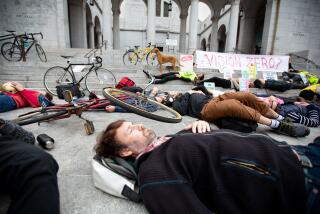2009 traffic casualty rate at lowest in 60 years
- Share via
In 2009, the rate of traffic deaths and injuries in the U.S. reached its lowest point in nearly 60 years, Transportation Secretary Ray LaHood announced Thursday.
Although Americans drove slightly more than in 2008, traffic deaths were down 9.7% in 2009 and at their lowest number since 1950. The number and rate of injuries were the lowest recorded since 1988, when the National Highway Traffic Safety Administration first began estimating injury data. Motorcycle fatalities also declined for the first time in 11 years.
Alcohol-related fatalities dropped 7.4%, but NHTSA Administrator David Strickland noted that drunk driving was still a factor in about one-third of the more than 30,000 traffic deaths each year.
“We will continue to work with our state partners to strictly enforce both seat-belt use and anti-drunk-driving laws across this nation, every day and every night,” Strickland said in a statement.
Joan Claybrook, president emeritus at the nonprofit advocacy group Public Citizen, said the poor economy explained the lower death and injury rates.
“When the economy is down, discretionary driving drops substantially,” Claybrook said. “The people who are doing the driving are going to work. They’re much more serious and more careful.”
Improvements in car designs might be another factor, Claybrook said, noting that manufacturers now build SUVs that are lower to the ground, making them more resistant to rollovers, which can be particularly deadly.
Forty-one states, Puerto Rico and the District of Columbia had lower fatalities in 2009 compared with 2008. But nine others saw increased traffic deaths last year, including North Dakota, up 35%, and Rhode Island, up 28%. Alcohol-related deaths were up 92% in Vermont, 51% in South Dakota and 48% in Rhode Island.
Traffic deaths were down 14% in Florida and Pennsylvania, 13% in Illinois, 10% in California and 7.4% in Maryland. Alcohol-related deaths also declined in all those states, except for Maryland, where they rose 12%.
But an improved economy could disrupt the downward trend.
“Unfortunately, when the economy gets better, those deaths and injuries will go back up,” Claybrook said.
kim.geiger@latimes.com
More to Read
Sign up for Essential California
The most important California stories and recommendations in your inbox every morning.
You may occasionally receive promotional content from the Los Angeles Times.













